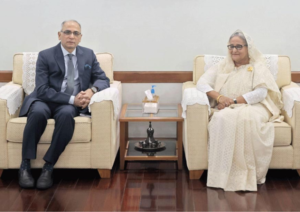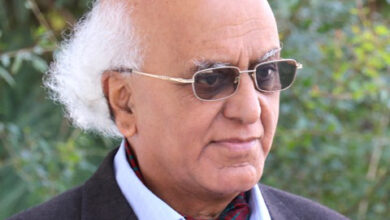Reaffirming Dhaka’s centrality in India’s Neighbourhood First

By SOHINI BOSE
The Indian Foreign Secretary, Vinay Mohan Kwatra, was on a two-day official visit to Bangladesh from 8–9 May. During the visit, he called on Bangladesh Prime Minister Sheikh Hasina, the Foreign Minister of Bangladesh Hasan Mahmud, and his counterpart, Foreign Secretary Masud Bin Momen. This visit is diplomatically important for several reasons. Since this was India’s first high-level official visit to the neighbouring country after its new government was formed in January 2024, it showcases the priority New Delhi accords to Dhaka. It follows Bangladesh Foreign Minister Hasan Mahmud’s visit to New Delhi and Kolkata earlier this year and lays the groundwork for PM Hasina’s probable visit to India this summer. Although neither the Indian Ministry of External Affairs nor the Bangladesh Foreign Ministry disclosed any details of the meeting, it was reported that the “two sides also discussed water-sharing issues of the common rivers, including that of the Teesta River, and the renewal of the Ganges Water Sharing Treaty, signed in 1996.” Mahmud went on say that “You know we have taken on a big project on the Teesta. India wants to finance that. We said the project will have to be in accordance with our needs; it must fulfill our needs.” This development unfolds as the Teesta issue is becoming intertwined with India’s apprehensions over China’s increasing influence in Bangladesh.
A potential dragon’s lair
In January 2024, the Chinese Ambassador to Bangladesh Yao Wen stated that he hoped that the Teesta project would soon be resumed, referring to Beijing’s 2022 proposal for implementing Dhaka’s Teesta River Comprehensive Management and Restoration project, worth US$ 1 billion. However, this offer adds a layer of geopolitical complexity to the long-standing bilateral problem of Teesta water-sharing between India and Bangladesh, which has remained unresolved because it has been bogged down by India’s federal politics, making it difficult to reach an international agreement. China’s involvement in the Teesta project would bring the ‘Dragon’ within 100 kilometres of the Indian border. This is especially concerning since it is close to the Siliguri corridor—a narrow stretch of land which is the only land link that connects the mainland of India to its Northeastern territories. This is a sensitive region for the Indian government as it contends with border disputes with China along the Arunachal Pradesh border.

Under such circumstances, India’s reported proposal to construct a reservoir on the Teesta River is promising. If the initiative materialises, it would solve a major stumbling block in India-Bangladesh ties. So far, Dhaka’s pause in accepting Beijing’s offer, its promise of considering geopolitical implications before doing so, and Mahmud’s optimism about a quick resolution of the Teesta issue after his return from India this February, have all been reassuring for New Delhi. However, India’s apprehensions will prevail until Bangladesh makes an actual choice between the two offers or arrives at a middle path.
The reality of China’s increased presence and investments in Bangladesh is undeniable. Currently, Beijing is Dhaka’s largest trade partner, third-largest source of Foreign Direct Investment (FDI), and its second-largest provider of foreign aid. Most of China’s aid like other foreign aid in Dhaka is channelled towards building developmental projects. Consequently, Beijing has been involved in building several crucial infrastructures in the country such as the Padma Multi-Purpose Rail and Road Bridge, the Karnaphuli River Tunnel, and the Chattogram and Mongla Ports. In recent months, PM Hasina has requested further investments from China to develop the southern part of her country and has also requested a US$ 5-billion soft loan to bail the country out of the ongoing economic crisis.
Civilian ventures aside, China has built Bangladesh’s first submarine base, the BNS Sheikh Hasina off the coast of Cox’s Bazaar in the Chattogram division. China is also a major source of Bangladesh’s weaponry; although lately, Dhaka expressed its dissatisfaction with the quality of the Chinese arms supply. Nonetheless, the upcoming first China-Bangladesh defence exercise scheduled for this month is expected to elevate the partnership once again. The decision to focus on UN peacekeeping counter-terrorism operations, as the exercise scenario is a diplomatic manoeuvre, underscoring the Hasina government’s ‘stance of ‘zero tolerance to terrorism’. Troops of the People’s Liberation Army of China are travelling to Bangladesh, where they will carry out drills at the Bangabandhu Bangladesh-China Friendship Exhibition Center in Rupganj, near Dhaka.
Nonetheless, the Awami League Government has always consciously maintained a diplomatic balance in its engagements between India and China. However, New Delhi is naturally apprehensive of China’s increasing influence in its neighbourhood—a region that is critical to the country’s economic and strategic interests and its foreign policy aspirations. It also used to make it clear to the US that targeting Hasina government on domestic political issues would only drive Dhaka closer to Beijing.
Diplomat’s defence
Thus, the recent visit comes at a significant moment, when there is a need to re-affirm the India-Bangladesh partnership in the face of the ‘dragon’s’ deepening footprint in Bangladesh. Accordingly, apart from discussing shared challenges such as the Teesta issue, killings of Bangladeshi nationals at the India-Bangladesh border, and the need for Rohingya repatriation, the two countries also discussed areas in which the bilateral partnership has excelled. These include energy, connectivity, and defence. Emerging opportunities for cooperation in green energy, digital economy, and space technology were also discussed.
Reasserting the strengths of the India-Bangladesh partnership is vital as anti-Indian sentiments brew in Bangladesh, manifesting in the ‘India Out’ and ‘Boycott Indian Products’ campaigns, flared by sections of the Opposition. This has the potential to push the people of Bangladesh away from India and accept China’s growing presence in the country. Thus, reassurance from India to resolve challenges and reminders about the milestones of cooperation is necessary to restore some of the country’s reportedly declining goodwill among the people of Bangladesh.
India and Bangladesh with their geographical contiguity and shared resources are natural partners and cooperation between the two countries is directly proportionate to their mutual development. The Indian Foreign Secretary’s visit reaffirms the mutual dependence to ensure that the ‘China-Bangladesh Golden Friendship 2024’ does not overpower the ‘Golden Chapter’ in India-Bangladesh relations.




